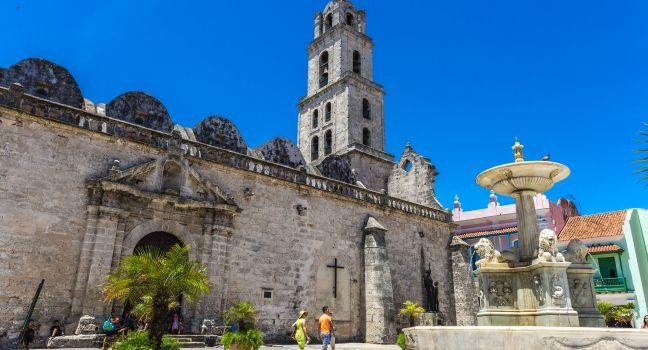What is now called the Old Square was originally Plaza Nueva (New Square), built as a popular alternative to Plaza de Armas, the military and government nerve center. Later called Plaza del Mercado (Market Square) as Havana's commercial hub, Plaza Vieja was the site of executions, processions, bullfights, and fiestas—all witnessed by Havana's wealthiest citizens, who looked on from their balconies. The original Carrara marble fountain surrounded by four dolphins was demolished in the 1930s when President Gerardo Machado (1871–1939) built an underground parking lot here. Today the square's surrounding structures vary wildly in condition, though all of them are noteworthy. Don't miss the splendid view west down Calle Brasil (Teniente Rey) to the Capitolio.
The impressive mansion on the square's southwestern corner is the Casa de los Condes de Jaruco (1733–37), the former seat of the Fondo Cubano de Bienes Culturales (BFC; Cuba's version of the National Endowment for the Arts). Its lush main patio is surrounded by massive, yet delicate, pillars. Look for the ceramic tiles along the main stairway and the second-floor stained glass windows. Today the building houses members of the Génesis Galerías de Arte and an upstairs restaurant. On the second floor La Casona Galería de Arte displays the works of contemporary Cuban and international artists, while on street-level Diago Galería de Arte shows the works of native Cuban painters. To your left as you exit is the interesting 1762 Elias Durnford painting A View of the Market Place in the City of the Havana [sic].
On the square's southeastern corner, the Palacio Viena Hotel (also known as the Palacio Cueto) is a 1906 Art Nouveau gem that was occupied by several-dozen families after the Revolution. The intense floral relief sculpture and stained-glass windows are still intact, if a little sooty, on all five stories. This building has perennially been under renovation, and it's anybody's guess when the grand structure will once again take its place in the square.
On the square's western edge is the 1752 Casa de Juan Rico de Mata (Calle Mercaderes 307), now housing the Fototeca de Cuba, a contemporary photography gallery that has rotating temporary exhibitions of Cuban and international photographers. Also along the western edge, heading north, you'll see the planetarium, housed in an old cinema, and the Camera Obscura, located in the 20th-century Villa Gómez. The Casa de las Hermanas Cárdenas (Calle San Ignacio 352), on the square's eastern side, was once used by Havana's first philharmonic society. It's now home to the Centro de Desarrollo de Artes Visuales (Center for the Development of Visual Arts), which hosts temporary exhibits.
In the 18th-century Casa del Conde San Estéban de Cañongo (Calle San Ignacio 356), you'll find the Artesanías para Turismo workshop. Strangely, a permanent exhibition here presents Wallonia, French Belgium, and its industry and agriculture, as well as its most noteworthy comics like Tintin. Apparently the exhibition was granted after Belgian interests put up the money to restore the building. There would probably be much more exciting ways to use this prime property than a pedantic exhibit that ultimately gives little to the creative life of the community.
While wandering along San Ignacio, notice the faded "vapores cuba–españa" ("steamboats cuba–spain") sign on the wall inside the entryway of No. 358. The 18th-century Casa del Conde de Lombillo (Calle San Ignacio 364; not to be confused with the Conde de Lombillo house in the Plaza de la Catedral) has lovely original murals in amber hues with faded blue and green floral motifs decorating its facade. Today it houses the charming Café Bohemia, which has upstairs suites for rent. The restoration of the 17th-century Colegio del Santo Angel (Calle Brasil/Teniente Rey 56, esquina de Calle San Ignacio) almost a decade ago. It was originally the house of Susana Benitez de Parejo, a wealthy young widow who departed for Spain in the mid-19th century; it was later used as an orphanage for boys under 12 years of age and then as a music conservatory until it collapsed in 1993, leaving only the facade standing. Now housing an excellent restaurant and 11 luxury apartments, this is one of the finest triumphs of the restoration work in Plaza Vieja.





